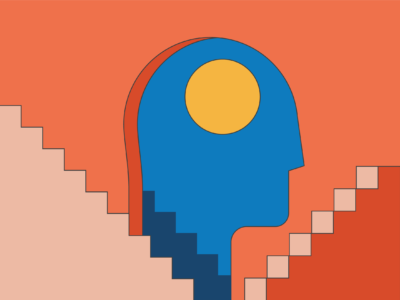
Everything you do—walking to your yoga class, making your favorite latte order, talking to your bestie, and just getting through the workday—happens thanks to your brain. Your brain is the control center for your entire body—it’s how you get shit done. So how can you take care of such a beautifully complex and integral part of your body and keep it in great shape for as long as possible?
Lara V. Marcuse, MD, a board-certified neurologist and codirector of the Mount Sinai Epilepsy Program at the Icahn School of Medicine at Mount Sinai, shares the one thing she does every day (or almost every day, because life gets busy, folks!) to keep her brain healthy. As a bonus? It’s fun.
Pick up a difficult new skill, even if you suck at it.
“I started playing piano in my mid-40s,” Dr. Marcuse tells SELF. It all started by chance when her son began taking lessons: “I took his lesson book on the sly one night before bed, and I was totally enthralled by it,” she says, though she admits she found the songs themselves hard to get into at first. “I’m a 1980s New York City club kid. I grew up on a steady diet of house music, and I never liked classical.” It’s been seven years since she first gave playing a Chopin piece a shot, and she hasn’t looked back since. “[Playing piano] helps me get into [the] nooks and crannies of myself—and into my spirit,” she says.
Taking up a hobby that’s unfamiliar and even difficult forces your brain to exercise new or rarely used neural pathways, and that can help prevent cognitive decline and even protect your brain against Alzheimer’s disease, a type of dementia that leads to memory loss and an inability to complete daily tasks. Keeping your brain active makes neural pathways strong—and the opposite is true if you’re not finding ways to engage your mind.
Playing an instrument, in particular, engages every facet of your brain. If you’ve ever looked at a sheet of music, it’s basically like reading a different language. Your brain goes through a bunch of hoops to figure it out. (Anecdotally speaking, as a former cello player, I can attest to the fact that reading music is no joke; I recall spending hours trying to understand a simple string of notes.) When you sit down to play the keys or strum a guitar, your brain is hard at work trying to tell your hands what to do.

Musical activities trigger the auditory cortex (a.k.a. the part of your brain that helps you hear) and areas of your brain that are involved in memory function. According to a 2021 review published in Frontiers in Neuroscience, performing music is rewarding and makes you want to continue your musical training practice. It also improves brain plasticity, which refers to ways your brain changes in response to external or internal factors, like a stroke or another traumatic brain injury, and how the brain adapts afterward. Learning how to play might result in structural and functional changes in your brain over time, exactly because it takes a while to learn.
Your brain-bolstering activity of choice doesn’t have to be music-based, Dr. Marcuse says, as long as you’re interested in whatever you’re doing enough to want to commit to it. You can paint, try tai chi, or learn how to interpret tarot cards.
The other key piece of this is making sure that your new hobby involves some amount of challenge. “It has to be something a little new that’s a little hard,” Dr. Marcuse says. Passively watching the latest episode of The Bachelor won’t cut it, because you need your brain to be active, take in new information, digest it, and then put it back out there.
While you might feel that learning a new skill feels daunting, that’s the point! According to Dr. Marcuse, you don’t have to be good at the activity to protect your brain: “I never took music lessons as a kid. I’m not really good at it. I never will be,” she says.
And despite not being the next Mozart, she says that playing the piano adds some color and levity to her days, in addition to protecting her brain. “I really need that in my life—I have a very stressful job,” she says. “It makes me feel that the world is sort of full of beauty and hope.”
How to make a new skill a regular part of your life—and why it’s great for your brain
You don’t have to do the activity every single day, or even for a very long time. “Just try to do it frequently, and don’t do it for very long,” Dr. Marcuse says. Sometimes all she has time for is a few bars or a couple of scales—do whatever works for you, as long as you stay somewhat in the swing of a routine.
A 2020 research study found that increasing the frequency with which you engage in your hobby (like doing crossword puzzles, playing board games—or an instrument—or reading the newspaper) decreases cognitive impairment and depressive symptoms in older populations. In other words, doing your hobby more often will be better for your overall well-being. Practice not only increases the speed at which you can perform a task, but it also improves your accuracy. Research theorizes that when you attempt an activity for the first time, specific brain regions are activated to help you complete the task; this creates new neural pathways as your brain stores all this new information in your memory as you continue practicing your skill over time.
Consistently training your brain will help boost your cognitive processes over time, because the myelin sheath—the layer of protein that coats your nerves—thickens. A plumper myelin sheath helps your brain transmit and process information more efficiently. (An added bonus of practicing: Even though the word routine sounds dull as all get-out, maintaining one can reduce your stress levels and make you happier in general.)
Whether you decide to take a cooking class or learn Spanish, try a new hobby that really speaks to you. “Everything you do to protect your brain is going to make your life better,” Dr. Marcuse says. Bearing that in mind: I think it’s time to pull out the ol’ cello that’s been collecting dust in my closet.
Original article here








 In recent years, there has been an upsurge in seaweed bathing, which is believed to be beneficial to health. A bath full of bladderwrack might not seem very appealing – but this strap-like, olive coloured seaweed, found along the coasts of the North Sea, Atlantic Ocean and Pacific Ocean, has been shown to have beneficial effects as a topical treatment for various skin issues from skin ageing to wound healing.
In recent years, there has been an upsurge in seaweed bathing, which is believed to be beneficial to health. A bath full of bladderwrack might not seem very appealing – but this strap-like, olive coloured seaweed, found along the coasts of the North Sea, Atlantic Ocean and Pacific Ocean, has been shown to have beneficial effects as a topical treatment for various skin issues from skin ageing to wound healing.